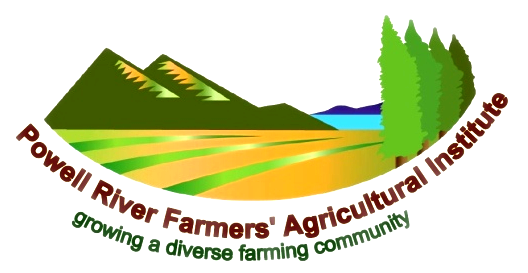Intro to Farming in Powell River

Powell River is a remote coastal community located on the mainland approximately 100 km north of Vancouver and directly across the Salish Sea from Vancouver Island. While only accessible by plane or ferry, Powell River has a vibrant farming and agricultural community.
Powell River is fortunate to have its Regional District declared a gmo-free seed zone, allowing farmers to grow produce organically from seed without the risk of cross-pollination from gmo crops.
There are a growing number of bee keepers and hives that help keep pollination successful. Our remote location creates a buffered ecosystem for both our crops and our livestock.
If you’re thinking of moving to Powell River to get into farming, you’re not alone. There are new farmers moving to town every year, some with a broad focus and some very specific.
When you move to a new place, it can be hard to find information on the local quirks in soil and climate, and sources for materials and equipment. This page will give you a head start on finding that local info.
Distribution of local crops takes on various forms. Many farmers have farm-gate sales right on their property, some bring their harvests to the local summer farmers markets and the winter market. Still others sell to small local stores, markets, restaurants and even some of the grocery chains. The opportunity for local distribution is varied and available year-round.
Powell River is a very supportive community as a whole and you will find that same support reflected across our farming community. Farmers are willing to share their experiences, expertise and discuss various methods they use or have tried over the years.
We have local licensed slaughter facilities as well as butchers to help get your meat ready for sale.
As a remote community, our success is further defined by our self-sufficiency through local producers.
New Farmers to Powell River
When you move to a new place, it can be hard to find information on the local quirks in soil and climate, and sources for materials and equipment. This page will give you a head start on finding that local info.
Soil and Water Conditions
Hwy 101 South
Soil varies by location. Black Point: sand and gravel on rocks. Very little topsoil.
Kelly Creek
Varies greatly! One FI member reports “our soil is very good – no rocks, sandy loam.” while another says “The soil is a very sandy mix with a good percentage of industrial gravel (rocks to double fist size ) mixed in. Digging is a real chore.”
Deep well water may contain arsenic – shallow wells generally do not.
Cranberry
Thin topsoil on top of very sandy subsoil
City water available in most areas
Wildwood
Clay soil in many areas
City water available in most areas
Planting Dates & Frost Dates
In general, the last average frost date is around the end of April. However, that varies locally due to micro-climates and it’s a very good idea to check in with gardeners and farmers close to you. Since that date is an average, not an absolute, frosts can easily occur after it.
Many people are fooled by our lack of apparent winter weather — and then lose everything in early May! Watch the weather forecast, and cover up at night as needed.
Manure Sources
Therapeutic Riding Association
Composting
BC Organic Matter Recycling Regulation
BC Agricultural Composting Handbook
A comprehensive resource from Cornell University
Value Products
Small Scale Food Processor Association
Guidelines for the sale of food at temporary markets
Pest Control
UBC Botanical Garden forums – Garden Pest Management (IPM, not Organic)
Bear Proofing:
Bear Aware BC
Bear Aware Powell River: Laurence Edwards 604 483-2334
Bear proof composter – Laurie Chambers
Biodiversity and Pollinator Insects
Hints and tips from the 7th Generation blog:
First and foremost, no insecticides, please. (Obvious, yes, but always worth saying!)
Second, don’t be afraid of bees! Very few species are aggressive. Most are exactly like us – they just want to be left alone to mind their affairs without trouble. Treat them respectfully, as friends not enemies, and you’ll co-exist quite peacefully.
Plant locally native species around your home to provide the food sources your growing zone’s pollinators need.
Remember that nature always knows best so consider letting parts of your yard “go wild” and return to their natural state.
Grow flowering plant species with different colors, shapes, and blooming times to provide plenty of attractive choices for different pollinators throughout your growing season.
Plant in clumps, which attract more pollinators than single standalone plants.
If you’re not in a drought zone, keep gardens well-watered so they produce more nectar.
Mow your grass less often so pollinator favourites like daisies, clover and other wildflowers can grow through and bloom.
Don’t just feed pollinators. Shelter them by putting up some bat houses and bee nests.
Leave dead tree trunks standing for wood-nesting bees.
Supply some water. Pollination is thirsty work so set out a shallow birdbath-like bowl with some water and floating wine corks and/or half submerged stones.
